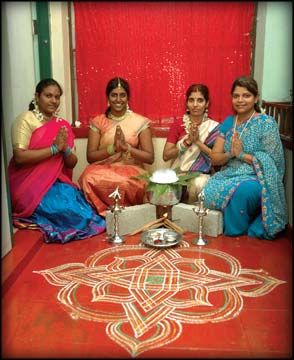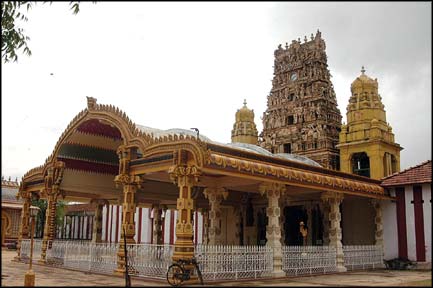|
Thai Pongal:
Thanksgiving to Sun God
By Shyamala Devi KARUNAKHARAN
Thai Pongal is one of the significant celebrations of Hindus world
over. It is celebrated on the first day of Tamil month Thai
(January-February) according to the Hindu almanac. This year, it falls
on January 14.
 Since the month Thai coincides with the paddy harvest, Thai Pongal is
also known as the harvest festival. Hindu farmers honour and thank the
Sun for its contribution in obtaining a bountiful harvest during the
season. In Tamil it is also called Uzhavar Thirunaal (farmersí
festival). Since the month Thai coincides with the paddy harvest, Thai Pongal is
also known as the harvest festival. Hindu farmers honour and thank the
Sun for its contribution in obtaining a bountiful harvest during the
season. In Tamil it is also called Uzhavar Thirunaal (farmersí
festival).
On this day, Hindus wake up before sunrise, bathe and wear new
clothes. The front courtyards of their homes are decorated with Kolams
(floor decoration) specifying the sacred area where Pongal will be
prepared.
Parallel lines are drawn in a square shape with a small opening in
the middle of one side illustrating an entrance. Kolam is usually made
with rice flour with the purpose for the ants and insects to feed on it.
The area selected in the garden for the celebration will have a
direct view of the Sun and will be garnished traditionally with coconut
and mango leaves and sugar cane.
A hearth arranged with three bricks will be placed in a corner of
this square-shaped Kolam. Then a clay pot of water with its neck tied
with a string of ginger and turmeric plants and mango leaves is placed
on the hearth.
Here for a change, the breadwinner of the family conducts the cooking
while the other family members cheerfully participate in the event.
When the water boils the washed rice is put into the pot by all
family members. They take turns and drop three handful of rice into the
pot.
The auspicious moment is the spill-over of the milk from the pot
which is considered prosperous.
This is when the family members light firecrackers to signify the
moment of joy.
Pongal (milk rice) is prepared using red raw rice, cooked in milk and
sweetened with jaggery. Other ingredients added are roasted green gram,
sugar candy, ghee, cashew nuts and plums. When the pongal is cooked, it
is then spread on a banana leaf with other sweetmeats and offered to the
Sun at a pooja with the participation of all family members.
The pongal will then be ready to serve and the family members sit
together and have the meal signifying unity and togetherness.
 |
|
Nallur Kandaswamy Kovil,
Jaffna |
Later it will be distributed to relatives, neighbours and friends.
The Hindusí commitment to protect their rich cultural heritage is
shown in observing the traditions of Thai Pongal. As it is the beginning
of the month, on this day they anticipate a future filled with hope and
optimism.
The customs and celebrations basically signify the expressions of the
renewal of the life circle. This is also the time to discard the old and
welcome the new.
Maattu pongal
The second day of pongal is celebrated by Hindu villagers as Maattu
Pongal to offer thanks to cattle as they too help farmers in various
ways in agriculture, next to Sun.
Long before the introduction of the marvels of science and
technology, such as tractors, mini tractors and water pumps, the man
used cattle to get all these jobs done, starting from ploughing the
field to pumping water from deep wells to irrigate the paddy fields.
So, the farmers pay their heartfelt tribute to these cattle with
great encouragement.
The cattle are bathed and decorated with kumkum and bells and fed
with pongal, bananas and sugar cane.
In some villages Jallikattu, a traditional sport where a specially
grown bull is tamed, is held with much commotion of joy. The day filled
with fun and frolic would carry the unpretentious spirit of an authentic
village life.
|

